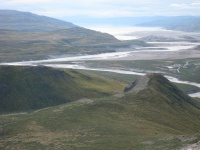CSDMS groups: Difference between revisions
No edit summary |
No edit summary |
||
| Line 123: | Line 123: | ||
}} [[HMC_Members|Members]] | }} [[HMC_Members|Members]] | ||
|- | |- | ||
|[[CSDMS_organization#Wolfgang Bangerth|Wolfgang Bangerth]] and [[CSDMS_organization# | |[[CSDMS_organization#Wolfgang Bangerth|Wolfgang Bangerth]] and [[CSDMS_organization#Sean Gallen|Sean Gallen]] | ||
|[[Geodynamics Focus Research Group|Geodynamics]] FRG | |[[Geodynamics Focus Research Group|Geodynamics]] FRG | ||
|{{#ask: [[User:+]][[Working group member::Geodynamics Focus Research Group]] | |{{#ask: [[User:+]][[Working group member::Geodynamics Focus Research Group]] | ||
Revision as of 14:47, 23 January 2024
Working Groups

CSDMS currently has five Working Groups, which includes three environmental (or discipline) working groups and two integrative working groups, seven focus research groups and three initiatives. As of today, CSDMS is proud to have 2553 members from 79 different countries (see also member distribution per country, or find out on a map where all CSDMS members are located). Working groups typically meet once per year, coordinating much of their activity via remote communication systems. Chairs of the Working Groups form the Executive Committee of CSDMS.
- Terrestrial Working Group (Co-Chairs, Leslie Hsu and Andrew Wickert), 1275 members, weathering, hillslope, fluvial, glacial, aeolian, lacustrial
- Coastal Working Group (Co-Chairs, Talea Mayo and Alejandra Ortiz), 960 members, delta, estuary, bays and lagoons, nearshore
- Marine Working Group (Co-Chairs, Mike Steckler and Julia Moriarty), 574 members, shelf, carbonate, slope, deep marine
- Education and Knowledge Transfer (EKT) Working Group (Chair, Kevin Xu), 434 members, targeting researchers with model & visualization tools; planners with decision-making tools; and educators with pre-packaged models to help illustrate surface processes, tools to build intuition.
- Cyberinformatics and Numerics Working Group (Co-Chairs, Olaf David and Scott Peckham), 360 members includes technical computational aspects of the CSDMS, ensures that the modeling system properly functions and is accessible to users; software protocols are maintained, along with model standardization and visualization; works with our cyberinformatic partners.
Focus Research Groups
CSDMS currently has six Focus Research Groups or FRGs. FRGs differ from Working Groups in that they serve a unique subset of our surface dynamics community, and usually represent a well-developed community. FRGs are often co-sponsored by another organization. FRGs are similarly supported by the CSDMS Integration Facility as Working Groups, including access to CSDMS High Performance Computers. FRG's typically meet once per year, coordinating much of their activity via remote communication systems. Chairs of FRGs report directly to the CSDMS Executive Director, and often to the Chair or Director of the co-sponsoring organization.
- Hydrology Focus Research Group, 1031 members, represents the hydrological modeling community, and is being co-sponsored by CUAHSI. This FRG deals with aspects of the hydrological system that impact earth-surface dynamics. (Chair, Anthony Castronova)
- Chesapeake Focus Research Group, 146 members, is our first 'geographically-focused' effort representing and co-sponsored by the Chesapeake Community Modeling Program, with their unique collection of models and field data set (Chair, Raleigh Hood)
- Geodynamics Focus Research Group, 431 members. represents the geodynamic modeling community, and is being co-sponsored by GeoPRISMS. This FRG deals with aspects of the geodynamic system that impact earth-surface. (Co-Chairs, Wolfgang Bangerth and Sean Gallen)
- Critical Zone Focus Research Group, 283 members, is originated to develop compatibility between CSDMS architecture & protocols and developed models & data produced by the co-sponsors Critical Zone Observatory and International Soil Modeling Consortium (Chair, Sagar Gautam)
- Human Dimensions Focus Research Group, 245 members. Represents the Human Dimensions community and is co-sponsored by the AIMS and CoMSES NET.(Co-Chairs, Moira Zellner and Derek Robinson)
- Ecosystem Dynamics Focus Research Group, 426 members. Represents the Ecosystem Dynamics community and is co-sponsored by the International Society for Ecological Modeling. (Co-Chairs, Todd Swannack and Candice Piercy)
Initiatives
CSDMS hosts five initiatives to advance earth-surface process modeling across disciplines. The Initiatives will connect researchers, and supports focused research on pressing scientific questions proposed by our research community and involve partnerships with scientists in the fields of ecology, global sustainability, coastal vulnerability and continental margin dynamics.
- Coastal Vulnerability initiative, 338 members represent the Coastal Vulnerability modeling community. This initiative deals with aspects of coastal vulnerability with emphasis on deltas and their multiple threats and stresses. (Chair, Talea Mayo)
- Continental Margin Initiative, 171 members represent the Continental Margin modeling community. The goal of this initiative is to model extreme oceanic and atmospheric events on generating turbidity currents in the Gulf of Mexico. (Chair, Courtney Harris)
- AI&ML initiative, 292 members represent the Artificial Intelligence & Machine Learning community. The goal of this initiative is to promote and support the uptake of artificial intelligence &machine learning for the surface model community. (Initiative leads: Chris Jenkins, Jeff Obelcz)
- Exploring interoperability of open modeling platforms Initiative, 183 members represent the open modeling platform interoperability community. The goal of this initiative is to investigate possibilities to make earth surface models that operate on a platform interoperable for other platforms. (Initiative leads: Min Chen, Albert Kettner)
- River Network Modeling Initiative, 277 members represent the community around the development and applications of modeling tools for river channel evolution, including sediment supply and transport. The initiative supports applications in basic and applied research and on timescales of <1 year to geologic timescales. (Initiative Chairs: Allison Pfeiffer and Katy Barnhart)
Groups Area
The links below will guide you to the different group web sites. Each community has its own web site set up, such to pursue their goals the best.
